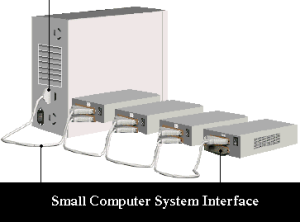This article gives the information about small computer system interface. SCSI is a set of standard for physically connection and transferring data between computer and peripheral devices. Small Computer System Interface in short form SCSI is most commonly used for hard disk and tape drives, but it can connect a large connection of other devices, including scanners, and optical drives (CD, DVD, etc). SCSI is very high speed parallel or serial interface which is used to connect up to seven devices to the computer system using only one interface card. SCSI is basically a bus into which different peripherals are connected in daisy chain. Each device is connected at the end of device in the chain like configuration.
Each and every device in the chain is given unique device identification number called SCSI ID. This number helps the SCSI controller to identify the device during data communication. SCSI is not devices level interface it is system level interface. Device level interface are specific to the drive interfacing these signals do not interface printer or scanner. System level interface is not based on specific to the device instead it uses signals that are converted from device level signals to the signals used by the host computer system. Hence it can interface HDD, printers, scanners, etc. It requires special types of adapter is called SCSI adapter. A 50pin cable used for connecting internal SCSI devices and thick shielded cable used for connecting external SCSI devices. Subsystem on the SCSI bus behaves in two different ways: Initiator and target. The SCSI adapter is initiator and the peripheral devices are usually the targets. It uses hand shaking protocol. Up to 8 subsystems can exit on a SCSI bus. It is used in special servers and RISC system.
There are 3 different SCSI standards SCSI 1, SCSI-2, SCSI 3.
- SCSI – 1:
SCSI was the first implementation of SCSI. The major features of SCSI are as follow:
- 8 bit parallel bus.
- 5 MHz asynchronous and synchronous operation.
- 4 MBPS (Asynchronous) Or 5MBPS (synchronous) throughput.
- 50 pin cable.
- Single ended unbalanced transmission.
- Passive termination.
- Optional bus parity.
- SCSI – 2:
SCSI 2 is the improved version of SCSI -1 added several optional feature:
- Fast SCSI (10 MHz)
- Wide SCSI (16 bit transfers)
- Command queuing
- New commands
- High density 50 pin cable connectors.
- Active termination for improved single ended transmission.
- High voltage differential transmission for longer bus lengths.
- SCSI – 3:
It is the latest SCSI implementation SCSI-3 is a term used to describe a set of standards currently being developed.
Unlike SCSI-1 and SCSI 2, SCSI 3 is not one document that covers all the layers and interface of SCSI. If covers the primary commands, specific command sets, and electrical interface and protocols. The command set include hard disk interface command, for tape drives, control commands for RAID and other commands.
The main addition to SCSI 3 includes following:
- Ultra 2 (fast 40) SCSI.
- Ultra 3 (fast 80 DT) SCSI.
- Ultra 4 (fast 160 DT) SCSI.
- Ultra 5 (fast 320 DT) SCSI.
- New low voltage differential signaling.
- Elimination of high voltage differential signaling. This is what about SCSI.
